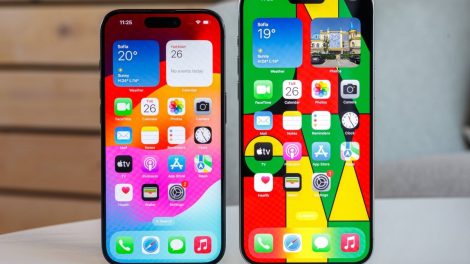Apple’s iPhone lineup has always been at the forefront of smartphone innovation, setting trends that often define the industry. With each release, the company refines its designs, enhances performance, and introduces new features that keep millions of users worldwide invested in its ecosystem. Now, as speculation grows around the forthcoming iPhone 17 models, there’s confirmation that Apple will continue with one of its most talked-about recent design changes: the Dynamic Island. All iPhone 17 models are set to feature the same-sized Dynamic Island as the iPhone 16 series, marking a significant step toward design consistency across the lineup.

The Dynamic Island, introduced with the iPhone 14 Pro and expanded to all models with the iPhone 15 lineup, has quickly become a defining characteristic of Apple’s flagship devices. This interactive display cutout not only replaces the static notch but also serves as a functional hub for notifications, alerts, and quick-access features. Its integration into the design represents Apple’s ability to merge form and function seamlessly. The decision to maintain the same size Dynamic Island across the iPhone 17 models reflects a deliberate strategy aimed at unifying the user experience while retaining the aesthetics that have become synonymous with Apple’s brand.
Consistency is a hallmark of Apple’s design philosophy. From the symmetry of its hardware to the uniformity of its software interfaces, Apple places a high value on creating a cohesive experience across its products. By carrying over the same-sized Dynamic Island from the iPhone 16 series to the iPhone 17 models, Apple is not only simplifying production but also reinforcing a sense of familiarity for users. This decision aligns with the company’s broader approach to incremental innovation—refining and perfecting existing features rather than making dramatic, unnecessary changes.
The Dynamic Island’s functionality has evolved since its initial debut, becoming more versatile and integral to the iPhone experience. It serves as a dynamic space for real-time updates, such as live sports scores, music controls, and app notifications, offering users a more interactive way to engage with their devices. Its design also allows developers to integrate app functionalities into the island, further enhancing its utility. By standardizing the size of the Dynamic Island across all iPhone 17 models, Apple is ensuring that every user, regardless of which model they choose, can access the same features without compromise.
To fully understand the significance of this move, it’s important to consider the evolution of the iPhone’s display design. When Apple introduced the notch with the iPhone X, it was met with mixed reactions. While some appreciated its unique design, others viewed it as an intrusion on the otherwise seamless display. The introduction of the Dynamic Island addressed many of these concerns, transforming the notch from a static element into an interactive feature. This shift not only improved functionality but also changed the way users perceive display cutouts. By continuing with the same-sized Dynamic Island for the iPhone 17, Apple is doubling down on this success, reinforcing its commitment to a design choice that has resonated with consumers.
The decision to maintain a consistent Dynamic Island size also has implications for app developers and the broader iOS ecosystem. Developers rely on predictable hardware dimensions to create apps that work seamlessly across devices. By keeping the size of the Dynamic Island unchanged, Apple is providing developers with a stable framework, reducing the need for constant adjustments and ensuring that apps can fully leverage the feature’s capabilities. This consistency benefits users as well, as it ensures that their favorite apps continue to deliver a polished and reliable experience.
From a production standpoint, standardizing the Dynamic Island size across the iPhone 17 models is a strategic move. Apple’s supply chain is renowned for its efficiency, and this decision simplifies the manufacturing process by reducing the number of display variants required. This streamlining not only lowers production costs but also minimizes the risk of supply chain disruptions—a critical factor in an industry where demand for new devices often exceeds supply at launch. Furthermore, a standardized design allows Apple to allocate resources more effectively, focusing on other areas of innovation that can enhance the overall user experience.
To illustrate the practical advantages of this decision, consider the following comparison of production and feature integration benefits:
| Aspect | Dynamic Island Standardization | Varied Dynamic Island Sizes |
|---|---|---|
| Manufacturing Complexity | Simplified | Increased |
| App Developer Support | Consistent | Fragmented |
| User Experience | Unified | Uneven |
| Supply Chain Efficiency | High | Moderate |
As seen in this comparison, the standardization of the Dynamic Island size offers clear advantages across multiple dimensions. It simplifies manufacturing, enhances developer support, and creates a more cohesive experience for users, all while maintaining Apple’s reputation for design excellence.
The decision to maintain the same-sized Dynamic Island also reflects broader trends in the smartphone industry. As competition intensifies, companies are increasingly focusing on features that differentiate their devices. For Apple, the Dynamic Island represents a unique selling point that sets its devices apart from competitors. By building on this feature and making it a standard across all iPhone 17 models, Apple is reinforcing its position as a leader in innovation while ensuring that its devices remain instantly recognizable.
While the consistency in Dynamic Island size may seem like a small detail, it speaks to Apple’s broader approach to product development. Rather than rushing to introduce new features for the sake of novelty, Apple takes a measured approach, refining existing technologies and integrating them more deeply into its ecosystem. This philosophy not only ensures that new features are polished and reliable but also builds trust among users who know they can count on Apple to deliver a consistent, high-quality experience.
The iPhone 17 models are expected to build on the success of their predecessors, offering incremental improvements in performance, battery life, and camera capabilities. However, the decision to retain the same-sized Dynamic Island underscores the importance of thoughtful design choices in shaping the user experience. By prioritizing consistency and functionality over unnecessary changes, Apple is demonstrating a commitment to its core values while paving the way for future innovations.
As you anticipate the release of the iPhone 17 models, it’s worth considering how this decision will influence your experience with the device. Whether you’re upgrading from an older iPhone or considering your first foray into Apple’s ecosystem, the Dynamic Island is set to remain a key feature that enhances usability and adds a touch of interactivity to your daily routine. Its integration across all models ensures that you won’t have to compromise on functionality, regardless of which version you choose.
Looking ahead, the continued evolution of the Dynamic Island will likely play a central role in Apple’s strategy for its flagship devices. As new software updates and app integrations expand its capabilities, the feature is poised to become even more integral to the iPhone experience. For now, the decision to standardize its size across the iPhone 17 lineup is a clear indication that Apple sees the Dynamic Island as a cornerstone of its design philosophy—a feature that not only enhances the aesthetics of its devices but also elevates their functionality.
In conclusion, Apple’s decision to maintain the same-sized Dynamic Island for the iPhone 17 models is more than just a design choice; it’s a statement of intent. By prioritizing consistency, functionality, and user experience, Apple is reinforcing its commitment to delivering devices that are as reliable as they are innovative. As you consider the impact of this decision, it’s clear that the Dynamic Island is here to stay, shaping the future of Apple’s iPhone lineup and setting a new standard for smartphone design.









Add Comment